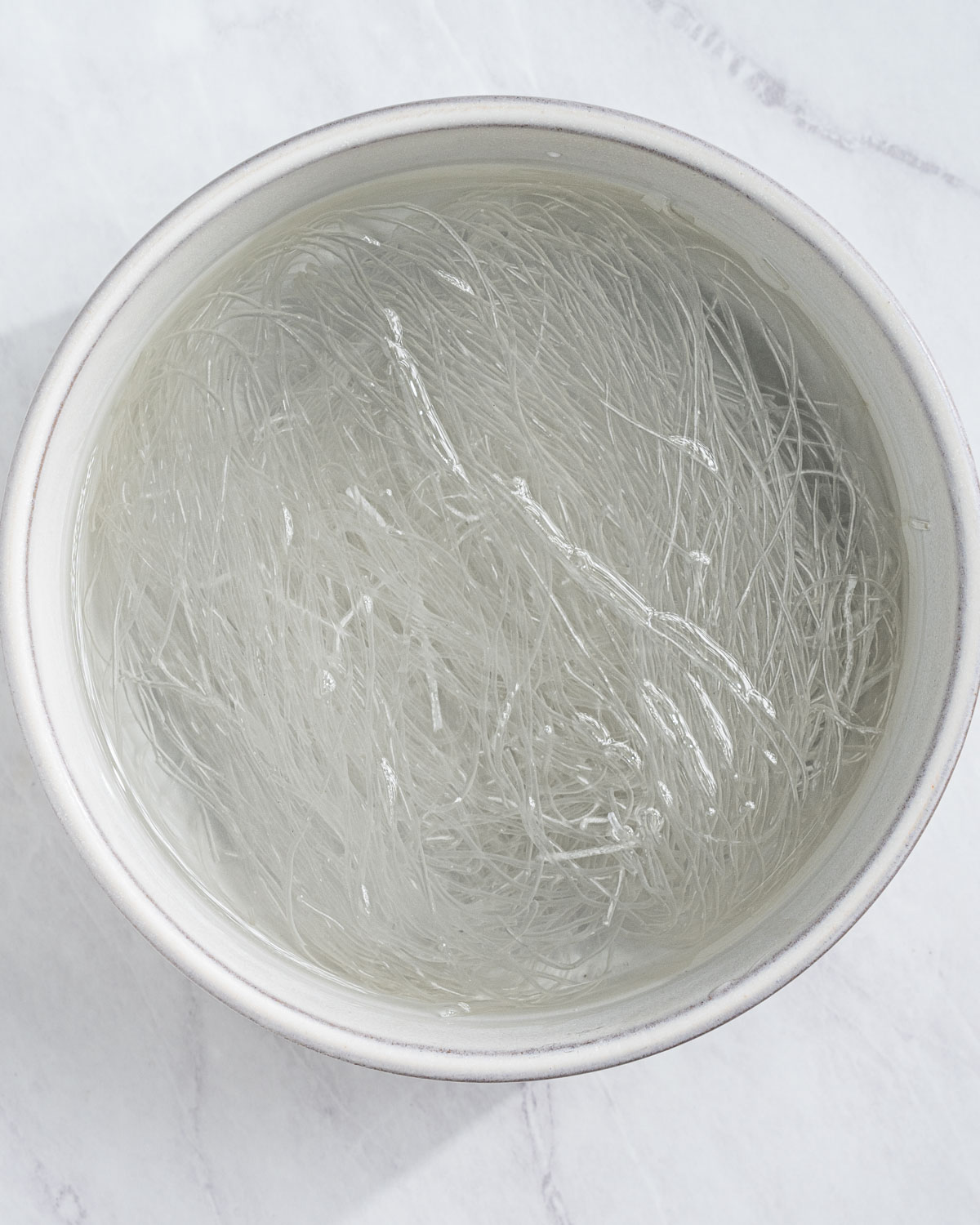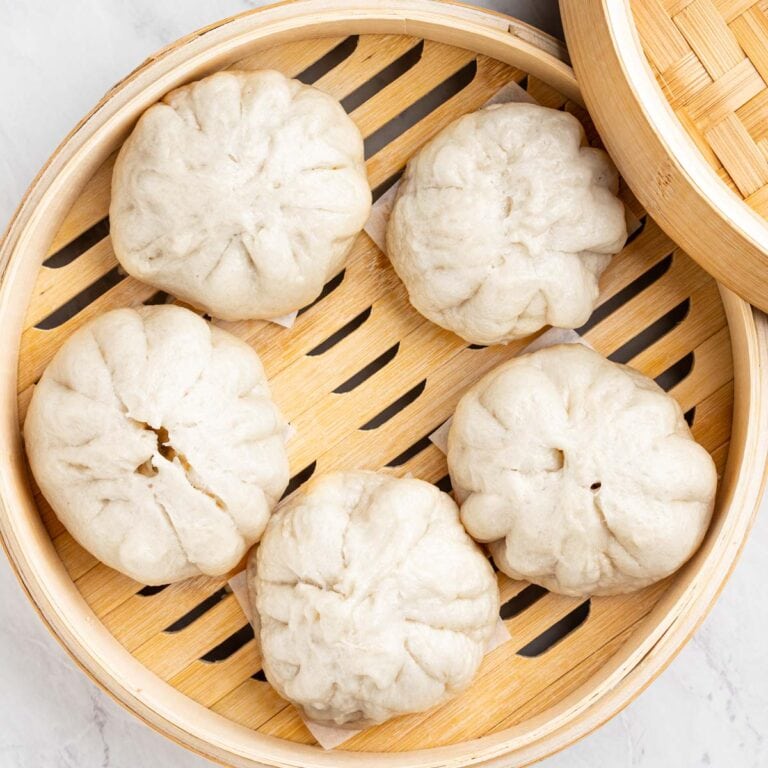How To Cook Rice Noodles
In Asian cooking, rice noodles are used for all sorts of delicious dishes, like stir-fries, soups, salads, and noodle bowls. Nailing that ideal texture can be a bit tricky. These noodles cook up fast, and if you overdo it, you will end up with a big bowl of mushy, clumpy mess. Here are some tips and tricks to ensure your rice noodles turn out absolutely perfect every single time.

Cooking rice noodles is a whole different ball game compared to wheat pasta. Unlike pasta, which usually requires a rolling boil to cook, rice noodles can be softened by soaking in water or blanching in hot water (depending on the size of the noodles). No need for a huge pot of bubbling water.
What are rice noodles?
Rice noodles are a type of noodle made from rice flour and water. You know those white noodles we often slurp up in Asian dishes? Well, they’re a superstar in cuisines like Chinese, Thai, Vietnamese, and more. These noodles come in all shapes and sizes, from super thin and delicate to wide and flat. Check out some of these popular rice noodle varieties:

- Rice Vermicelli (Bun): Made from fermented rice dough, which gives them their slippery texture. These are very thin rice noodles, often used in dishes like soups, noodle bowls, and spring rolls. They cook quickly and have a soft, delicate texture.
- Rice Stick Noodles (Pho): These are flat, wide rice noodles that come in different sizes (small, medium, large, and extra large) and are used in dishes like soups and stir-fries (Pad Thai). They are thicker than rice vermicelli but still flexible and quick to cook. You can find these dried on the shelf or fresh in the refrigerated section.
Rice noodles are gluten-free. So, if you’ve got gluten sensitivities, these are perfect. They’re not super flavorful on their own, but they’ve got this chewy yet slightly slippery texture when you cook them up.
The trick is to give them a nice hot water bath to soften before they join the party in your dishes. And speaking of dishes, these noodles are total chameleons. You can use them as the base for all sorts of deliciousness – stir-fries, soups, cold salads – you name it. They’re like the blank canvas of the noodle world, ready to soak up all the flavors you throw at them.
Recipes that use rice noodles
- Goi Cuon (Vietnamese Fresh Spring Rolls)
- Bun Thit Nuong (Vietnamese Noodle Bowl with Grilled Pork)
- Bun Cha Gio (Vietnamese Noodle Bowl with Egg Rolls)
- Beef Chow Fun or Hu Tieu Xao (Thick Stir-Fried Noodles with Beef)
- Pho Tai (Vietnamese Beef Noodle Soup)
- Bun Rieu (Vietnamese Crab and Tomato Noodle Soup)
- Pad Thai
Vermicelli (Bún)
Vermicelli is a type of noodle, but it’s very thin and resembles long, slender strands. They are popular in Vietnamese, Thai, and many other cuisines. They come in two sizes.

Fresh bun noodles are available at markets throughout Vietnam. You may be able to find fresh noodles at well-stocked Vietnamese grocery stores, but for most people, dried bun is much easier to get at Asian grocery stores, online, and some supermarkets. The key to successfully cooking them is not to oversoak them, as they can become mushy quickly.
They are often served alongside hot pots, in soups, in noodle bowls, or wrapped with other fillings in rice paper.
Rice vermicelli noodles are often mistaken for bean thread or glass noodles due to their shared thin, translucent appearance when cooked. This confusion arises from variations in terminology across regions and languages. Rice vermicelli noodles are known by various names, such as “bihun” in Indonesia, “sen mee” in Thailand, and “bún” in Vietnamese cuisine.
Rice vermicelli noodles are made from rice flour and water and are commonly used in Southeast Asian dishes. Glass noodles, also known as bean thread or cellophane noodles, are typically made from mung bean starch, sweet potato starch, or tapioca and are more prevalent in Chinese, Japanese, and Korean cuisine.
Dried Flat Rice Noodles (Phở)
Dried flat rice noodles, also known as rice sticks, are made by soaking rice in water, grinding it up, and adding more water to make it liquid. The mixture is then spread thinly, steamed, and cut into noodles. They come in a variety of sizes: small, medium, large, and extra large.

In Vietnam, fresh pho noodles are sold everywhere, but they might be harder to find depending on where you live. You may be able to find it in most well-stocked Asian grocery stores. Dried pho noodles are more readily available in most Asian grocery stores, online, or in some supermarkets. They can be used for stir-fries or soups, depending on your preference. When you buy them dried in a package, they are hard and need to be soaked in water and blanched before use.
Small (2mm): Used in soups like Vietnamese Pho.
Medium (3mm): Used in soups or stir-fried dishes like Pad Thai.
Large (5mm) and Extra Large (10 mm): Used in stir-fried dishes like Pad See Ew or Beef Chow Fun.
Fresh Rice Noodles
Fresh rice noodles also come in a variety of sizes. The two common ones are small (for pho) and large and wide (for stir fry).
“Ho fun” or “chow fun” noodles are a type of rice noodle that is wide, flat, and usually quite thick. They’re great for absorbing flavors in stir-fries.
The fresh noodles just need a quick blanch in hot water to rehydrate it again.

How to Cook Vermicelli
Rice noodles should be soaked prior to boiling to ensure proper rehydration. You’ll know they’re ready when they can be bent in half without being hard or brittle. Soaking and cooking times/temperature will vary depending on the type of noodle.
- Soak the rice vermicelli in cold water for 30 minutes.
- Separate the soaked noodles. Cook in boiling water for 30 seconds to 1 minute until cooked through but not mushy.
- Drain the water and run the noodles in cold water, gently separating them with your hands.


Serve rice vermicelli in hot pot or wrap them in rice paper
The noodles will get stuck together, so it’s a good idea to serve them in small portions. Cut the noodles into easy-to-eat lengths.


How to Cook Dried Rice Stick Noodles
Rice noodles should be soaked prior to boiling to ensure proper rehydration. You’ll know they’re ready when they can be bent in half without being hard or brittle. Soaking and cooking times/temperature will vary depending on the type of noodle.
Thin Rice Noodles
- Soak in cold water for 1 hour OR lukewarm (body temperature) water for 30 minutes.
- Put one portion of noodles in a strainer with a handle. Dip the noodles in a pot of boiling water for 20-30 seconds. Transfer to a serving plate.
Thick Rice Noodles
- Place rice noodles in hot water (140-160°F) for about 12-15 minutes.
- Drain well. Rinse with cold water and transfer it to serving bowls or plates.


Testing for Doneness: After the noodles have softened and are flexible but still slightly chewy, taste a strand to check if they’re done. They should be al dente, as they will continue to cook when added to your dish.
Draining: Once the noodles are at the desired texture, drain them in a colander and rinse them under cold running water. This helps stop the cooking process and removes excess starch.
How to Cook Fresh Rice Noodles
- Put one portion of noodles in a strainer with a handle. Dip the noodles in a pot of boiling water for 15-20 seconds. (Thicker noodles need 1-2 minutes).
- Rinse them under cold running water. This helps stop the cooking process and removes excess starch before being added to your dish. Transfer to a serving bowl.



Frequently Asked Questions
To determine when rice noodles are done, taste a strand to ensure they are tender but still slightly firm, similar to al dente pasta. Additionally, check package instructions for specific cooking times, as they may vary by brand and noodle thickness. Once they reach the desired texture, promptly drain and rinse the noodles under cold water to halt the cooking process.
Rice noodles have a mild, neutral flavor. They are loved for their ability to absorb the flavors of the sauces, broths, or ingredients they are cooked with, making them a versatile and adaptable ingredient. Their primary appeal lies in their smooth, slightly chewy texture rather than their taste, which allows them to complement a wide range of savory and sweet dishes.
Yes, you can often use rice noodles as a substitute for wheat noodles in recipes, especially if you have gluten sensitivities. Keep in mind that rice noodles have a different texture and may require adjustments in cooking methods. Be sure to consider the specific requirements of your recipe to ensure the best results when making the substitution.
To prevent rice noodles from sticking together, rinse them under cold water right after cooking to remove excess starch and cool them down. Additionally, lightly toss the cooked noodles with a small amount of oil, like vegetable or sesame oil, to create a protective coating that reduces stickiness. When storing, place them in an airtight container or resealable plastic bag, removing as much air as possible to minimize moisture retention and clumping.
Yes, rice noodles are generally gluten-free. They are made from rice flour and water, and they don’t contain wheat or other gluten-containing grains. However, it’s essential to check the packaging for potential cross-contamination or shared facilities, especially if you have celiac disease or severe gluten sensitivity.
Yes, you can prepare rice noodles ahead of time for meal prepping. Slightly undercook the noodles, rinse them to stop the cooking process, and store them in airtight containers with a touch of oil to prevent sticking. When ready to use, simply reheat them in hot water or a stir-fry, allowing them to reach the desired texture during the reheating process.

How to Cook Rice Noodles
Ingredients
- vermicelli noodles
- dried flat rice noodles
- fresh wide rice noodles
Instructions
For Vermicelli Noodles
- Soak the rice vermicelli in cold water for 30 minutes.
- Separate the soaked noodles. Cook in boiling water for 30 seconds to 1 minute until cooked through but not mushy.
- Drain the water and run the noodles in cold water, gently separating them with your hands.
For Dried Flat Rice Noodles
- Small and Medium (thin noodles)Soak in cold water for 1 hour or lukewarm (body temperature) water for 30 minutes.Put one portion of noodles in a strainer with a handle. Dip the noodles in a pot of boiling water for 20-30 seconds. Transfer to a serving plate.
- Large and Extra Large (thick noodles)Place rice noodles in hot water (140-160°F) for about 12-15 minutes. Drain well. Rinse with cold water and transfer it to serving bowls or plates.
For Fresh Rice Noodles
- Put one portion of noodles in a strainer with a handle. Dip the noodles in a pot of boiling water for 15-20 seconds. (Thicker noodles need 1-2 minutes).
- Rinse them under cold running water. This helps stop the cooking process and removes excess starch. Transfer to a serving bowl.









Very informative and detailed! I enjoyed learning about the differences!